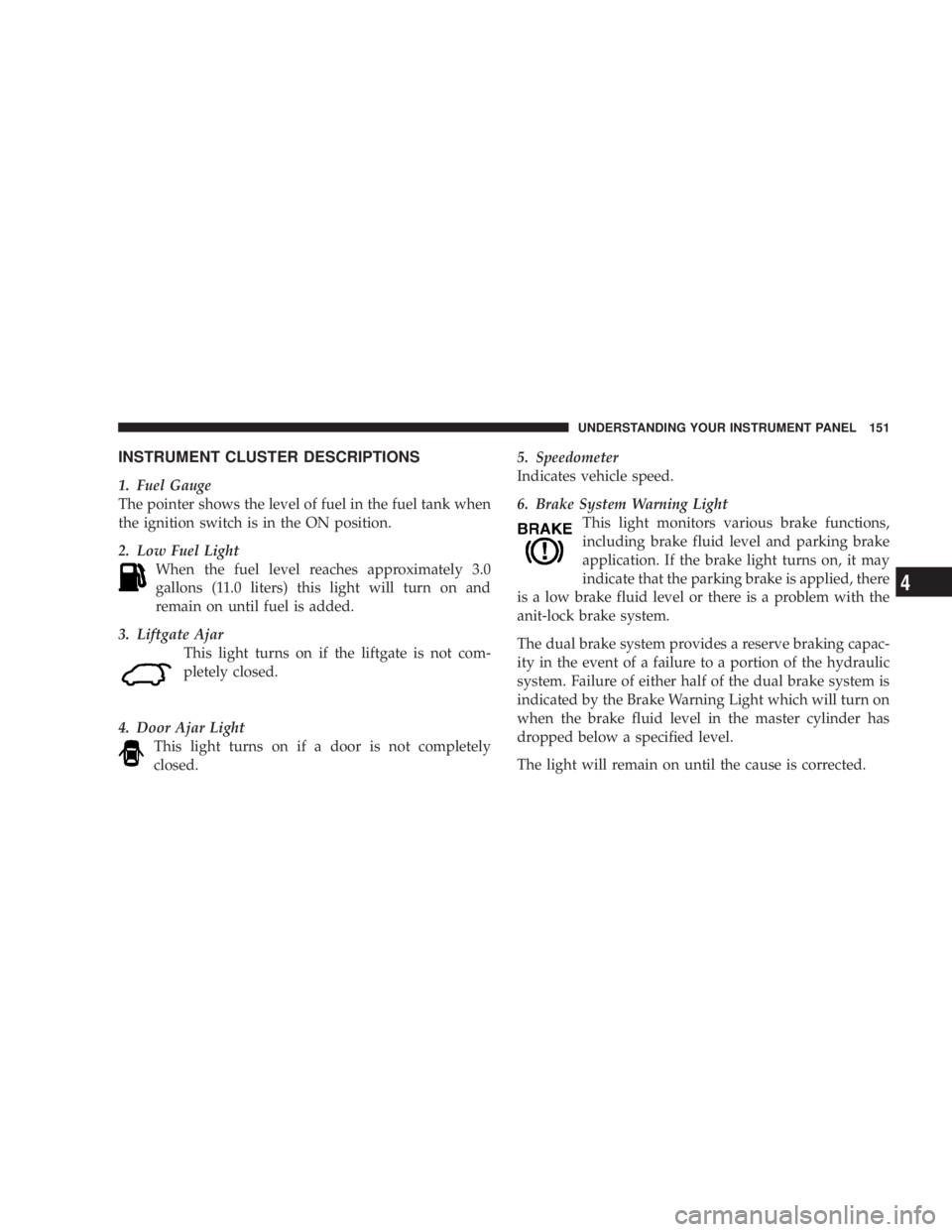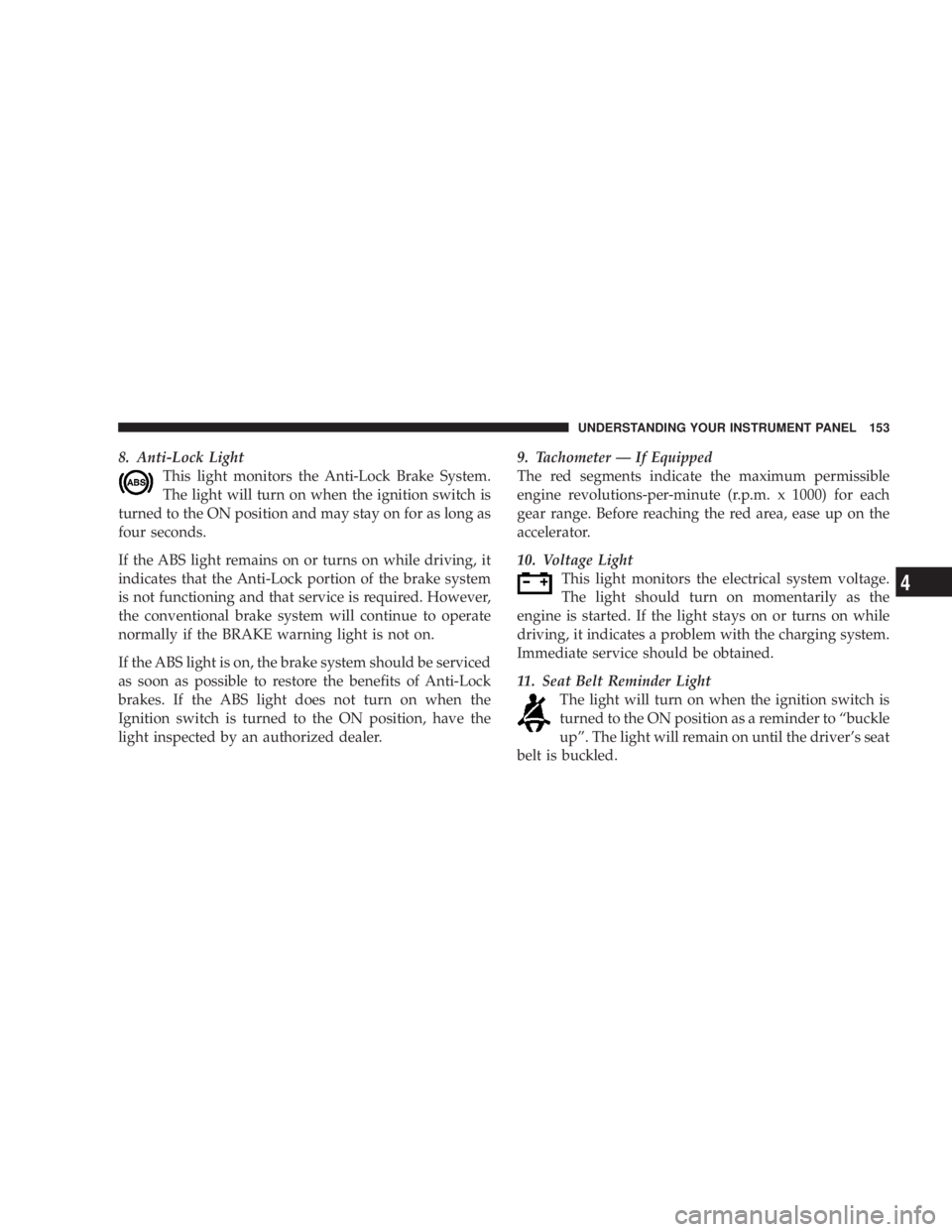Page 138 of 397
WARNING!Do not load objects over 20 lbs (9 kg) in the upper
position. Failure to follow this warning could cause
the cargo organizer to collapse resulting in personal
injury.
CAUTION!Do not load objects over 100 lbs (45 kg) in the lower
position. Failure to follow this could cause damage
to the cargo organizer. To Open Storage Compartments
1. Pull up on the center opening of the cargo organizer.
2. Lift up on the storage compartment dividers and lock
into place.138 UNDERSTANDING THE FEATURES OF YOUR VEHICLE
Page 140 of 397

capacity of the vehicle. Be sure the total load of cargo
inside the vehicle plus that on the external rack does not
exceed the maximum vehicle load capacity.
To move the cross bars, press the upper edge of each
cross bar button pass the detent, then move the cross bar
to the desired position. Once the cross bar is in place,
press the lower edge of the cross bar button to lock it into
position.
Attempt to move the crossbar again to ensure that it has
properly locked into position. NOTE: To help control wind noise when installing the
cross bars make sure that the arrows marked on the front
side of the cross bars are facing the front of the vehicle.
Also, when the cross bars are not in use the notch on the
cross bars should be aligned with the arrows on the side
rails. This will help reduce the amount of wind noise
when the crossbars are not in use.
The tie down holes on the cross bar ends should always
be used to tie down the load. Check the straps frequently
to be sure that the load remains securely attached.140 UNDERSTANDING THE FEATURES OF YOUR VEHICLE
Page 142 of 397
If the leveled vehicle is not moved for approximately 15
hours, the leveling system will bleed itself down. The
vehicle must be driven to reset the system.
WARNING!Do not install the load leveling system on vehicles
that are not equipped with Anti-Lock Brakes. Ve-
hicles without Anti-Lock Brakes (ABS) have a
height-sensing proportioning valve. Installing a lev-
eling system will render this system ineffective,
inappropriately reducing rear brake pressure, result-
ing in increased stopping distances. You could have
an accident. 142 UNDERSTANDING THE FEATURES OF YOUR VEHICLE
Page 143 of 397
UNDERSTANDING YOUR INSTRUMENT PANELCONTENTS m Instruments And Controls .................148
m Base Instrument Cluster ..................149
m Instrument Cluster With Tach ..............150
m Instrument Cluster Descriptions ............151
m Information Center Ð If Equipped ..........159
N Turn Signal Indicators ..................159
N High Beam Light .....................159
m Electronic Digital Clock ..................159
N Clock Setting Procedur e.................160 m Radio General Information ................160
N Radio Broadcast Signals .................160
N Two Types Of Signals ..................160
N Electrical Disturbances ..................160
N AM Reception .......................161
N FM Reception ........................161
m Sales Code RAZÐAM/ FM Stereo Radio With
Cassette Tape Player, CD Player And CD
Changer Controls Ð If Equipped ...........161
N Operating Instructions Ð Radio ...........1614
Page 144 of 397

N Power Switch, Volume Control ............162
N Seek Button (Radio Mode) ...............162
N Tuning .............................162
N PTY (Program Type) Button ..............162
N Balance ............................164
N Fade ..............................164
N Tone Control ........................164
N AM/FM Selection .....................164
N Scan Button .........................164
N To Set The Radio Push-Button Memory ......165
N To Change From Clock To Radio Mode ......165
N Operating Instructions Ð Tape Player .......165
N Seek Button .........................165 N Fast Forward (FF) .....................166
N Rewind (RW) ........................166
N Tape Eject ...........................166
N Scan Button .........................166
N Changing Tape Direction ................166
N Metal Tape Selection ...................166
N Pinch Roller Release ...................167
N Noise Reduction ......................167
N Operating Instructions Ð CD Player ........167
N Inserting The Compact Disc ..............167
N Seek Button .........................168
N EJT CD (Eject) Button ..................168
N FF/Tune/RW ........................169144 UNDERSTANDING YOUR INSTRUMENT PANEL
Page 151 of 397

INSTRUMENT CLUSTER DESCRIPTIONS
1. Fuel Gauge
The pointer shows the level of fuel in the fuel tank when
the ignition switch is in the ON position.
2. Low Fuel Light
When the fuel level reaches approximately 3.0
gallons (11.0 liters) this light will turn on and
remain on until fuel is added.
3. Liftgate Ajar
This light turns on if the liftgate is not com-
pletely closed.
4. Door Ajar Light
This light turns on if a door is not completely
closed. 5. Speedometer
Indicates vehicle speed.
6. Brake System Warning Light
This light monitors various brake functions,
including brake fluid level and parking brake
application. If the brake light turns on, it may
indicate that the parking brake is applied, there
is a low brake fluid level or there is a problem with the
anit-lock brake system.
The dual brake system provides a reserve braking capac-
ity in the event of a failure to a portion of the hydraulic
system. Failure of either half of the dual brake system is
indicated by the Brake Warning Light which will turn on
when the brake fluid level in the master cylinder has
dropped below a specified level.
The light will remain on until the cause is corrected. UNDERSTANDING YOUR INSTRUMENT PANEL 151
4
Page 152 of 397

NOTE: The light may flash momentarily during sharp
cornering maneuvers which change fluid level condi-
tions. The vehicle should have service performed.
If brake failure is indicated, immediate repair is neces-
sary.
WARNING!Driving a vehicle with the brake light on is danger-
ous. Part of the brake system may have failed. It will
take longer to stop the vehicle. You could have an
accident. Have the vehicle checked immediately.
Vehicles equipped with Anti-Lock brakes (ABS), are also
equipped with Electronic Brake Force Distribution (EBD).
In the event of an EBD failure, the Brake Warning Light
will turn on along with the ABS Light. Immediate repair
to the ABS system is required. The operation of the Brake Warning Light can be checked
by turning the ignition switch from the OFF position to
the ON position. The light should illuminate for approxi-
mately four seconds. The light should then turn off
unless the parking brake is applied or a brake fault is
detected. If the light does not illuminate, have the light
inspected by an authorized dealer.
The light also will turn on when the parking brake is
applied with the ignition switch in the ON position.
NOTE: This light shows only that the parking brake is
applied. It does not show the degree of brake application.
7. Airbag Light
This light turns on and remains on for 6 to 8
seconds as a bulb check when the ignition
switch is first turned ON. If the light is not on
during starting, stays on, or turns on while
driving, have the system inspected by an authorized
dealer as soon as possible.152 UNDERSTANDING YOUR INSTRUMENT PANEL
Page 153 of 397

8. Anti-Lock Light
This light monitors the Anti-Lock Brake System.
The light will turn on when the ignition switch is
turned to the ON position and may stay on for as long as
four seconds.
If the ABS light remains on or turns on while driving, it
indicates that the Anti-Lock portion of the brake system
is not functioning and that service is required. However,
the conventional brake system will continue to operate
normally if the BRAKE warning light is not on.
If the ABS light is on, the brake system should be serviced
as soon as possible to restore the benefits of Anti-Lock
brakes. If the ABS light does not turn on when the
Ignition switch is turned to the ON position, have the
light inspected by an authorized dealer. 9. Tachometer Ð If Equipped
The red segments indicate the maximum permissible
engine revolutions-per-minute (r.p.m. x 1000) for each
gear range. Before reaching the red area, ease up on the
accelerator.
10. Voltage Light
This light monitors the electrical system voltage.
The light should turn on momentarily as the
engine is started. If the light stays on or turns on while
driving, it indicates a problem with the charging system.
Immediate service should be obtained.
11. Seat Belt Reminder Light
The light will turn on when the ignition switch is
turned to the ON position as a reminder to ªbuckle
upº. The light will remain on until the driver's seat
belt is buckled. UNDERSTANDING YOUR INSTRUMENT PANEL 153
4